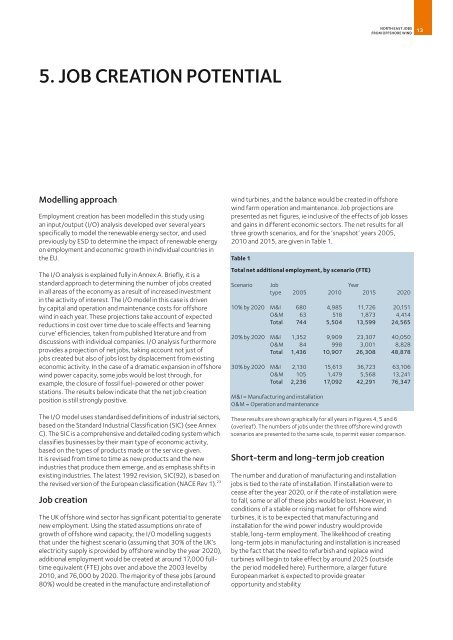offshore wind onshore jobs - a new industry for ... - Greenpeace UK
offshore wind onshore jobs - a new industry for ... - Greenpeace UK
offshore wind onshore jobs - a new industry for ... - Greenpeace UK
You also want an ePaper? Increase the reach of your titles
YUMPU automatically turns print PDFs into web optimized ePapers that Google loves.
NORTH EAST JOBS<br />
FROM OFFSHORE WIND<br />
13<br />
5. JOB CREATION POTENTIAL<br />
Modelling approach<br />
Employment creation has been modelled in this study using<br />
an input/output (I/O) analysis developed over several years<br />
specifically to model the re<strong>new</strong>able energy sector, and used<br />
previously by ESD to determine the impact of re<strong>new</strong>able energy<br />
on employment and economic growth in individual countries in<br />
the EU.<br />
The I/O analysis is explained fully in Annex A. Briefly, it is a<br />
standard approach to determining the number of <strong>jobs</strong> created<br />
in all areas of the economy as a result of increased investment<br />
in the activity of interest. The I/O model in this case is driven<br />
by capital and operation and maintenance costs <strong>for</strong> <strong>offshore</strong><br />
<strong>wind</strong> in each year. These projections take account of expected<br />
reductions in cost over time due to scale effects and ‘learning<br />
curve’ efficiencies, taken from published literature and from<br />
discussions with individual companies. I/O analysis furthermore<br />
provides a projection of net <strong>jobs</strong>, taking account not just of<br />
<strong>jobs</strong> created but also of <strong>jobs</strong> lost by displacement from existing<br />
economic activity. In the case of a dramatic expansion in <strong>offshore</strong><br />
<strong>wind</strong> power capacity, some <strong>jobs</strong> would be lost through, <strong>for</strong><br />
example, the closure of fossil fuel-powered or other power<br />
stations. The results below indicate that the net job creation<br />
position is still strongly positive.<br />
The I/O model uses standardised definitions of industrial sectors,<br />
based on the Standard Industrial Classification (SIC) (see Annex<br />
C). The SIC is a comprehensive and detailed coding system which<br />
classifies businesses by their main type of economic activity,<br />
based on the types of products made or the service given.<br />
It is revised from time to time as <strong>new</strong> products and the <strong>new</strong><br />
industries that produce them emerge, and as emphasis shifts in<br />
existing industries. The latest 1992 revision, SIC(92), is based on<br />
the revised version of the European classification (NACE Rev 1). 23<br />
Job creation<br />
The <strong>UK</strong> <strong>offshore</strong> <strong>wind</strong> sector has significant potential to generate<br />
<strong>new</strong> employment. Using the stated assumptions on rate of<br />
growth of <strong>offshore</strong> <strong>wind</strong> capacity, the I/O modelling suggests<br />
that under the highest scenario (assuming that 30% of the <strong>UK</strong>’s<br />
electricity supply is provided by <strong>offshore</strong> <strong>wind</strong> by the year 2020),<br />
additional employment would be created at around 17,000 fulltime<br />
equivalent (FTE) <strong>jobs</strong> over and above the 2003 level by<br />
2010, and 76,000 by 2020. The majority of these <strong>jobs</strong> (around<br />
80%) would be created in the manufacture and installation of<br />
<strong>wind</strong> turbines, and the balance would be created in <strong>offshore</strong><br />
<strong>wind</strong> farm operation and maintenance. Job projections are<br />
presented as net figures, ie inclusive of the effects of job losses<br />
and gains in different economic sectors. The net results <strong>for</strong> all<br />
three growth scenarios, and <strong>for</strong> the ‘snapshot’ years 2005,<br />
2010 and 2015, are given in Table 1.<br />
Table 1<br />
Total net additional employment, by scenario (FTE)<br />
Scenario Job Year<br />
type 2005 2010 2015 2020<br />
10% by 2020 M&I 680 4,985 11,726 20,151<br />
O&M 63 518 1,873 4,414<br />
Total 744 5,504 13,599 24,565<br />
20% by 2020 M&I 1,352 9,909 23,307 40,050<br />
O&M 84 998 3,001 8,828<br />
Total 1,436 10,907 26,308 48,878<br />
30% by 2020 M&I 2,130 15,613 36,723 63,106<br />
O&M 105 1,479 5,568 13,241<br />
Total 2,236 17,092 42,291 76,347<br />
M&I = Manufacturing and installation<br />
O&M = Operation and maintenance<br />
These results are shown graphically <strong>for</strong> all years in Figures 4, 5 and 6<br />
(overleaf). The numbers of <strong>jobs</strong> under the three <strong>offshore</strong> <strong>wind</strong> growth<br />
scenarios are presented to the same scale, to permit easier comparison.<br />
Short-term and long-term job creation<br />
The number and duration of manufacturing and installation<br />
<strong>jobs</strong> is tied to the rate of installation. If installation were to<br />
cease after the year 2020, or if the rate of installation were<br />
to fall, some or all of these <strong>jobs</strong> would be lost. However, in<br />
conditions of a stable or rising market <strong>for</strong> <strong>offshore</strong> <strong>wind</strong><br />
turbines, it is to be expected that manufacturing and<br />
installation <strong>for</strong> the <strong>wind</strong> power <strong>industry</strong> would provide<br />
stable, long-term employment. The likelihood of creating<br />
long-term <strong>jobs</strong> in manufacturing and installation is increased<br />
by the fact that the need to refurbish and replace <strong>wind</strong><br />
turbines will begin to take effect by around 2025 (outside<br />
the period modelled here). Furthermore, a larger future<br />
European market is expected to provide greater<br />
opportunity and stability




![[2007] EWHC 311 - Greenpeace UK](https://img.yumpu.com/22079793/1/184x260/2007-ewhc-311-greenpeace-uk.jpg?quality=85)











